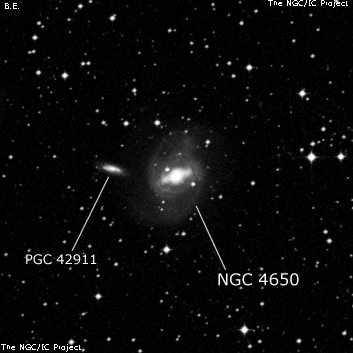NGC/IC Project Restoration Effort
(This is a very very beta version)
NGC4661


Basic Information
Location and Magnitude
Right Ascension: 12:45:14.9
Declination: -40:49:28
Constellation: CEN
Visual Magnitude: 13.5
Historic Information
Discoverer: Herschel J.
Year of discovery: 1834
Discovery aperture: 18.3
Observational
Summary description: F, pL, R, gbM
Sub-type: E-S0
Corwin's Notes
=====
NGC 4661 has often been referred to in the literature as "NGC 4650B". At
first glance, we might think this alternate designation comes from deV's
"Stromlo 13" monograph on the southern Shapley-Ames galaxies. But there is no
trace of it there.
"NGC 4650B" does appear, however, in RC2. Tracing it back from there leads to
a paper in Astrophysics and Space Science (volume 19, page 387, 1972) by J. L.
Sersic and E. L. Aguero -- who refer to it only as "G7" in a southern chain of
galaxies. So, the awkward notation does indeed originate in RC2 (sigh). My
guess is that Antoinette noticed that it and "G5" are near NGC 4650 and,
following Gerard's example, put "NGC 4650A" on "G5" and "NGC 4650B" on "G7".
So how did everyone miss the original NGC number? The NGC declination is 17
arcmin in error, but is not marked as uncertain, nor is it truncated as many
of the NGC positions are. The only indication in GC that something is amiss
is the number of observations used: "1::". Otherwise, that, too, is given to
the usual full precision that JH adopted.
Going on back to the CGH observations, though, we find that JH has only one
observation of the galaxy in June of 1834, just a few months after his arrival
at the Cape. And the position there is given only to a full minute of time in
RA, and an arcminute in NPD. Both are marked with plus-minus signs, and JH
has no notes of explanation.
Given that, and the fact that "NGC 4650B" is the only galaxy around that JH
could have reasonably seen -- his object nearly identifies itself in spite of
the crude position.
Steve's Notes
=====
NGC 4661
24" (4/12/08 - Magellan Observatory, Australia): at 200x this Centaurus cluster member (AGC 3526) was moderately bright, fairly small, elongated 2:1 WNW-ESE, 0.8'x0.4'. Located just 1' S of a 45" pair of mag 12.5 stars and 11.7' SE of NGC 4661.



